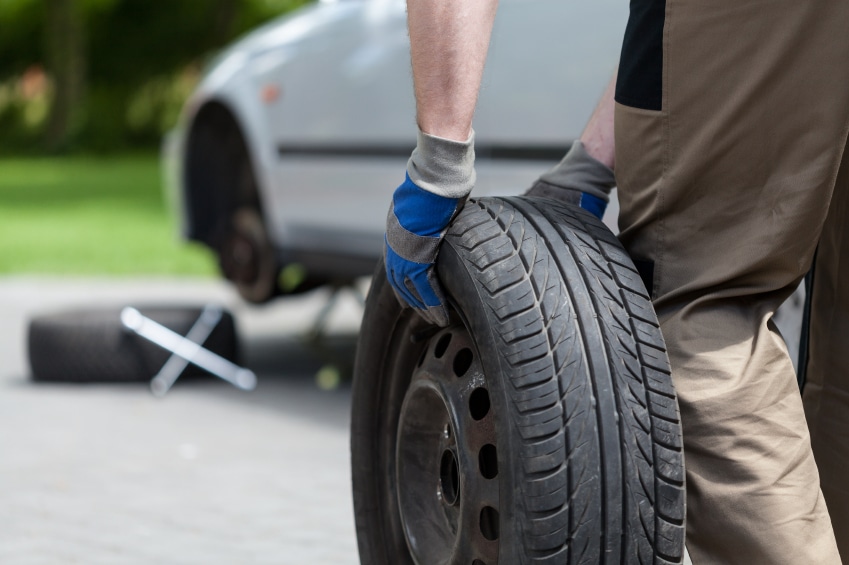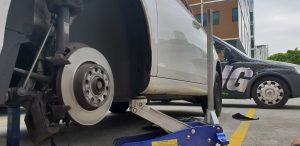Flat Tyres can happen anywhere. You might end up stranded along the side of the road with no cellphone service! It is easy enough if you exert a little effort with the right know-how and simple tools.
Here are our recommendations on how to complete the job safely and help your car get back on the road.
Items you need to fix a Flat Tyre
• Jack
• Lug Wrench
• Fully inflated spare Tyre
Step 1: Find a Safe location
As soon as you realize you have a flat tire, do not abruptly brake or turn. If you’re in on a busy city street, try to make your way to a side street. If you’re on the highway, be sure to pull over to the right shoulder.
Step 2: Turn on your hazard lights
Your hazard lights or “flashers” will help other drivers see you on the side of the road. You can also use other warning devices as required by your local highway code (emergency warning triangle) to ensure that you’re seen by oncoming traffic.
Step 3: Apply the parking brake and put the car into the “Park” position.
Once stopped, always use the parking brake when preparing to replace a flat tire. This will minimize the possibility of your vehicle rolling.
Step 4: Place a heavy object
Like a piece of wood or brick – behind and in front of one of the tyres you’re not lifting, to prevent rolling and increase stability.
Step 5: Take out the spare tire and the jack
The exact location of your spare tire can vary depending on the type of vehicle you drive. In many compact cars, the spare tire is located in the trunk under a latch.
Step 6: Take off the hubcap or wheel cover.
If a hubcap is covering the lug nuts (they’re in a circle at the center of your wheel), take this off before you go any further. it’s easier to remove the hubcap before lifting the vehicle with the jack. Use the flat end of your lug wrench to remove the hubcap or screwdriver to pry the wheel cover off. This will work for most vehicles, but some hubcaps need a different tool to come off. But If your lug nuts are exposed, you can do the next step.
Step 7: Loosen the lug nuts
With the lug wrench, twist the lug nuts counter-clockwise. You might need to use your foot or apply your body weight to loosen them. Loosen the lug nuts about ¼ to ½ of a turn, but don’t remove them completely yet. Save that for when it’s time to remove your tire/wheel from the vehicle.
Step 8: Position the jack under the vehicle
The right place for the jack is usually beneath the vehicle frame alongside the tire that’s flat. To safely lift and avoid damage to the vehicle, follow the instructions for jack placement in your vehicle owner’s manual.
Step 9: Jack up the vehicle about 6 inches off the ground.
You need to lift it high enough to remove the flat tire and replace it with a spare. As you lift, make sure that the car is stable. If you notice any instability, lower the jack and fix the problem before fully lifting the car.
Step 10: Remove the flat tire.
Remove the nuts the rest of the way. At this stage, you should be able to twist them off with your fingers. Grasp the flat tire with both hands and pull it straight toward you. Set it on its side so that it doesn’t roll away.
Step 11: Mount the spare tyre on the lug bolts
Put it on the wheel hub by aligning the rim with the lug bolts. Ease the tire onto the car until the lug bolts are visible through the rim.
Step 12: Tighten the nuts by hand
Put the lug nuts back on the lug bolts and tighten them all the way by hand. Once they are all on, check each one again, tightening as much as possible. You will tighten them with the wrench after lowering the vehicle to the ground.
Step 13: Lower the car without applying full weight on the tire
Use the jack to lower the vehicle so that the spare tire is resting on the ground but the full weight of the vehicle isn’t fully on the tire. At this point, you should tighten the lug nuts with the wrench, turning clockwise, as much as you can. Push down on the lug wrench with the full weight of your body.
Step 14: Lower the car completely
Bring the vehicle all the way to the ground and remove the jack. Give the lug nuts another pull with the wrench to ensure they’re as tight as possible.
Step 15: Put the old tire in your trunk and take it to a mechanic.
Don’t forget to put all of the tools used in your vehicle before driving away.
Drive cautiously until you’re able to visit a tire technician since temporary spare tires aren’t made to drive long distances or at high speeds. Knowing how to fix a flat tire is great, but regular tire maintenance is even more important.
Auto King mobile mechanics can come to you for any vehicle repair, service, and inspection needs. Book or Call for a free quote!





